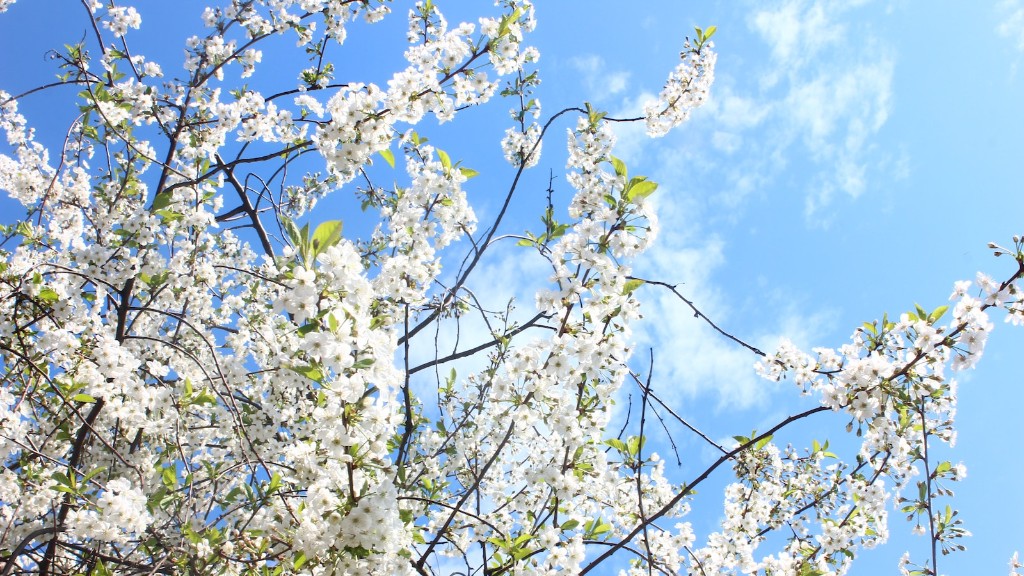General Care
Cherry trees need to be carefully managed to ensure their health and longevity. Proper pruning and grafting are essential for the development of the tree, as is proper care for the roots and crown. Fertilization should be done in the early spring and midsummer, with a balanced fertilizer. Irrigation should be done as necessary in a moderate and regular schedule. Pesticides and fungicides should only be used when necessary, and strictly according to the manufacturer’s instructions.
Insects and Diseases
Insects and diseases can harm a cherry tree, so avoidance and early detection is essential. Common pests include Japanese beetles, aphids, and worms. Common diseases include the shot hole fungus, brown rot, crown gall, and bacterial spot. To ward off potential damage, you can use insecticidal soap and treat with fungicidal sprays when necessary. Pruning and grafting can also help prevent diseases, as can proper watering and fertilization.
Protection from Animals
Animals like mice, squirrels, deer, and birds can also damage a cherry tree. To protect your tree, you can put a physical barrier around the trunk. A mesh fence or plastic netting can be used for this purpose. Repellant sprays and ultrasonic repellants can also help keep animals away, as can motion-activated devices and sound repellants.
Protection from Heavy Winds
Heavy winds can cause damage to a cherry tree, so protection is essential. Planting windbreaks such as trees, shrubs, and hedges can provide some protection. Covering the tree with burlap or a canopy is also an effective way to protect from wind damage.
Light Management
Cherry trees need plenty of sun, but too much can cause sunburn. To ensure the right amount of sunlight, you can employ strategies such as planting trees in a location that gets filtered sun, using a sunshade such as cheesecloth, or using a reflective or whitewash paint on the trunk and branches.
Insecticide Protection
When necessary, insecticides should be applied as directed. Neem oil and other natural insecticidal soaps can be used. For severe infestations, chemical insecticides may also be used. It is important to follow the directions closely and make sure the insecticide you are using is labeled for cherries.
Pest Control
Cherry trees can be prone to pest infestations, so prevention and prompt treatment is important. You can use physical barriers, such as trunk wraps and deterrent sprays. Monitoring the tree regularly can help you spot any signs of infestation early and treat them accordingly.
Preventative Practices
The best way to protect your cherry tree is with good preventative practices. Wiping leaves off regularly, pruning and grafting, proper fertilization and irrigation, and avoiding injury from tools and other items are all important. Following local advisories for pest and disease control can also help protect your tree.
Propagation
Propagation is a great way to protect a cherry tree if the original is damaged or in danger. It can also be used to produce multiple trees from one original. Grafting, tissue culture, and root cuttings are all popular methods of propagating cherry trees.
Pruning and Grafting
Pruning and grafting are essential for the health and longevity of a cherry tree. Pruning should be done when the tree is in its dormant season. Grafting can be done in the early spring, before the plant begins to bloom. Proper care should always be taken to avoid injury or damage to the tree.
Essential Nutrients
Cherry trees need essential nutrients, such as nitrogen, phosphorus, and potassium, to stay healthy. Fertilizers should be applied in the early spring and midsummer to ensure the tree has the right amount of nutrients and minerals. Organic fertilizers are considered to be the best for cherry trees.
Micro-Organism Interaction
A healthy micro-organism population in the soil is important for the health of cherry trees. Beneficial bacteria, fungi, and other microorganisms can help the tree absorb nutrients and provide protection from disease. Composting and adding organic matter, like compost, to the soil can help promote the growth of a healthy, beneficial micro-organism population.
Mulching
Mulching around a cherry tree can help maintain soil moisture and keep the tree healthy. Organic mulches, such as leaves, straw, and hay, are best. Mulch should be applied 3 to 4 inches thick, carefully avoiding contact with the trunk.
Soil Management
Soil management is essential for the health of any cherry tree. The soil should be well-draining but also retain enough moisture for the tree. Potting soil, loam, and sand are all suitable for growing cherry trees, though loam is generally preferred. Lime and gypsum can be added to the soil to adjust its pH level.
Importance of Watering
Watering is incredibly important for cherry trees. Irrigation should be done on a moderate and consistent schedule. A drip irrigation system or soaker hose is recommended to ensure proper and even water coverage. Avoid excessive or insufficient water, as both can be damaging to the tree.


